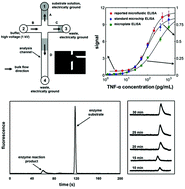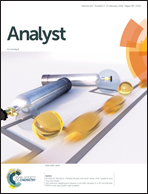Microfluidic ELISA employing an enzyme substrate and product species with similar detection properties
Abstract
The requirement for an enzyme label to carry out a chemical reaction directly at the signaling region of the enzyme substrate in order to produce a large change in its detectability places a significant constraint on the scope of enzyme-linked immunosorbent assays (ELISAs). In particular, this requirement limits the kinds of enzyme label–substrate couples employable in ELISAs and prevents their independent optimization with respect to the enzyme reaction and the detectability of the enzyme reaction substrate/product. The detection limit and multiplexing capabilities of the assay are consequently restricted in addition to rendering the technique applicable to a narrow range of assay conditions/samples. Attempting to address some of these limitations, the current article describes a microfluidic ELISA method that does not require the enzyme label to act around the signaling region of the substrate molecule. A highly detectable rhodamine based substrate was synthesized to demonstrate the reported assay which upon cleavage by the enzyme label, alkaline phosphatase, transformed from a monoanionic to a monocationic species, both of which had nearly identical fluorescence properties. These species were later separated based on their charge difference using capillary zone electrophoresis in an integrated device yielding a quantitative measure for the analyte (human TNF-α) in our sample. Impressively, the noted approach not only enabled the use of a new kind of enzyme substrate for ELISAs but also allowed the detection of human TNF-α at concentrations over 54-fold lower than that possible on commercial microwell plates primarily due to the better detectability of the rhodamine dye.



 Please wait while we load your content...
Please wait while we load your content...